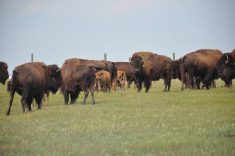RAPID CITY, S.D. – If you’ve got bison, you’ve also got cattle – at least a little bit.
Geneticist Jim Derr says cattle genes are present in nearly all commercial bison herds.
Whether this is a problem is part of a larger genetic issue.
Bison enjoy significant health advantages over other bovines, in part because of extreme natural selection created by their near extinction in the 19th century, added veterinarian David Hunter of Turner Enterprises during the International Bison Conference held in Rapid City in late July.
Read Also

Trump’s tariffs take their toll on U.S. producers
U.S. farmers say Trump’s tariffs have been devastating for growers in that country.
However, that process also resulted in a highly limited genetic base.
It is estimated that wild herds were reduced to a few dozen animals in the United States’ Yellowstone National Park and 250 head in Canada’s Wood Buffalo National Park.
Further complicating matters were efforts to crossbreed some of the remaining animals with cattle. The few ranchers who saved the estimated 500 bison that were in private hands hoped to improve domestic behaviour and increase meat production in the animals. The effort largely failed.
The result was the breeding of cattle genes into nearly all of today’s bison herds. Most hybrids appear 100 percent bison, but their genetic profile tells a different story.
Derr estimated that six to seven percent of the 500,000 bison alive today are uncontaminated by cattle genes and that nearly all of those in commercial, state or nongovernmental organization herds contain cattle DNA.
Derr’s Texas A&M genetics project has sampled 5,246 bison from 12 American federal herds, looking for cattle genes and found evidence of only 14 hybrids.
However, he said those numbers don’t tell the whole story because nuclear DNA from crossbreeding can be well hidden, especially after the number of generations that have passed since Charles Buffalo Jones’ cattalo experiments of the 1880s.
Officially, only one American herd remains pure: 400 animals in South Dakota’s Wind Cave National Park. However, Derr said technology still doesn’t exist to conclusively say any population is purely bison.
Curtis Strobeck, a professor emeritus of the University of Alberta, said tests of individual animals are unreliable when it comes to nuclear DNA. Mitochondrial DNA (mtDNA) is easier to spot.
“Purity, if it exists, of any bison population is always going to be suspect,” he said.
Derr pointed out that mtDNA number only 16,000 base pairs while nuclear DNA number more than three billion.
He said one of the problems with the hybrids stems from mtDNA.
He feared that hybridization may be causing large amounts of variability in bison’s mtDNA.
Passed through the female, defective or unsuitable mtDNA can reach disease-causing thresholds. Defective mtDNA at half to one percent of the total in a body are known to cause problems in humans such as heart defects, kidney disease, diabetes, strokes, diseases of the eye and brain and other genetic failures.
Mitochondria supply the power for cells. When cells don’t get enough or the right purity of energy, it results in serious cellular disease.
“There is 12 times the amount of mtDNA variability in (hybrid) bison. And it means disease management is unpredictable.”
Derr said mtDNA variability might be responsible for highly variable weight gains and health issues in some hybrid animals.
“If a herd shows no indication of hybridization then it would be criminal to (genetically) commingle those animals with the hybrids,” he said.
The Texas A&M project has shown that other American federal herds have low numbers of cattle genes, such as Yellowstone, Grand Teton, Roosevelt and Badlands. Several state herds, including one in Utah, are also low.
A private herd owned by broadcasting magnate Ted Turner at his Vermejo Park Ranch in New Mexico is considered to be nearly pure.
Derr said genetic testing is necessary to establish the purity of herds, but he cautioned that due to errors, overall population studies are important to qualify results.
He said modern bison breeders often remove aggressive animals from their herds. These and other traits that may not be a good fit for ranching are often desirable in wild animals.
“We are likely breeding out what makes a bison a bison,” he said. “At the same time we may be breeding out genetic resistance to disease.”
Derr said it is important to ensure the few pure herds that remain are kept that way for future generations and for research. For example, he said, bison appear to have natural resistance to disease from folded prions, which cause BSE, and as a result may hold a key to future genetic adaptation in cattle.
Strobeck said genetic purity has value for several reasons.
“If I was setting up a bison herd, which I’m not going to do, I would try to obtain animals from Custer State Park sales and other herds I knew were as pure as possible. Not necessarily for health reasons, but it would likely make a herd more marketable if it didn’t appear to have any cattle genes in it,” he said.
“From a genome perspective it makes sense to keep animals that are pure as pure as possible.”
Murray Woodbury directs the specialized livestock research program at the Western College of Veterinary Medicine in Saskatoon.
“When it comes down to it, we can do a lot of good breeding work with the (bison) genetics we have available, cow genes or not. We have the tools to build better herds that finish faster and deliver better muscling and make producers more money,” he said.
“Producers, governments and researchers have the tools to keep bison (as) bison, and still improve herds so that farmers can make a living from them. But it’s been difficult to get everyone to agree on what can and should be done and to fund it accordingly.”
Despite having a narrow genetic base, the most genetically pure herds have some of the lowest incidence of inbreeding, Derr said.














